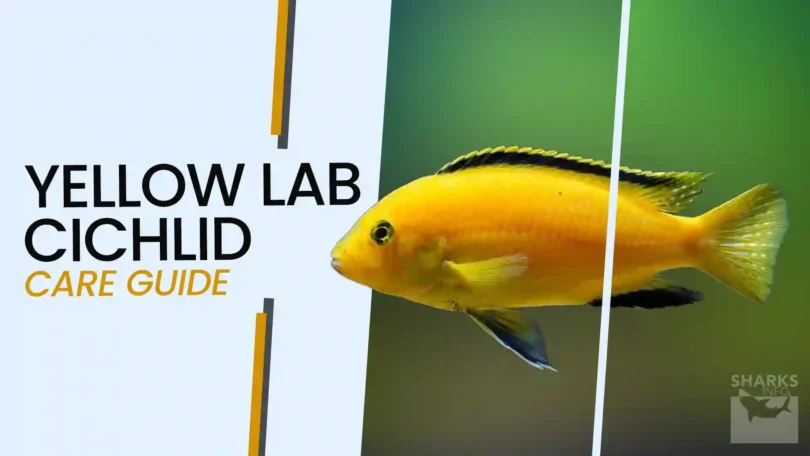The Yellow Lab Cichlid, originating from the rocky shores of Lake Malawi in East Africa, has gained popularity among aquarists globally. Their bright yellow bodies, contrasted with striking black fins, make them a vibrant centerpiece in any aquarium. With their dynamic personalities and relatively low maintenance needs, the Yellow Lab Cichlids have become a favored option for both beginners and experienced aquarium hobbyists alike.
To make it more exciting, the article here provides you with a care guide where we will delve into everything you need to know about this amazing fish species. So, let’s get started with their natural environment discussion first.
Natural Habitat
The Yellow Lab Cichlid, or Labidochromis caeruleus, hails from the rocky coastlines of Lake Malawi in East Africa. In its native habitat, the Yellow Lab inhabits the mid-water regions close to rocky areas. It thrives in the numerous caves and crevices found in the rock formations that line the lake’s shores.
The environment of Lake Malawi is unique and complex, and it is important for those who wish to keep Yellow Labs to replicate as many of these conditions as possible in their home aquariums. This includes ensuring the right water conditions, diet, and the inclusion of ample hiding places within the tank set up to mimic the rocky terrains these fish are accustomed to in their natural habitat.
Color and Pattern
True to its name, the Yellow Lab Cichlid is best known for its bright, lemon-yellow color with faint black stripes on the dorsal fin and at the edge of the caudal fin. The intensity of their color may fluctuate depending on factors like diet, health, and mood.
Size Differences
When it comes to size, Yellow Lab Cichlids are moderately sized fish. They typically grow to an average length of about 3.2 inches for females, and males can grow up to 4 inches in a well-maintained aquarium.
Behavior and Temperament
Understanding the Yellow Lab Cichlid’s behavior and temperament is key to ensuring a harmonious aquarium environment. Among the African cichlids, this species is renowned for its peaceful nature. They are generally good-natured and are less aggressive compared to their cichlid counterparts.
Also, they tend to show more curiosity and enthusiasm in exploring their surroundings, making them a lively addition to the aquarium.
That said, like many other cichlid species, Yellow Lab Cichlids do exhibit a degree of territorial behavior, especially during the breeding season.
Tank Size and Conditions
The size of the aquarium plays a pivotal role in the health and well-being of Yellow Lab Cichlids. For a pair of these fish, it is advised to have a minimum tank size of 30 gallons, but opting for a larger tank would be advantageous, particularly if you intend to keep them in a group.
In terms of substrate, Yellow Lab Cichlids prefer a sandy bottom, mimicking the lake floor of their native habitat. By providing sufficient space, they can express their natural behaviors, such as sifting through the sand to find food.
Feeding and Nutrition
In their natural habitat of Lake Malawi, their diet primarily consists of small invertebrates, algae, and zooplankton. Therefore, a balanced diet for these fish in captivity should reflect this dietary pattern.
Offer your fish food once or twice a day, ensuring to provide only what they can consume in a few minutes. Overfeeding not only affects their health but can also lead to water quality issues.
Tank Mates
As a general rule, the best tank mates for Yellow Lab Cichlids are other African cichlid species of similar size and temperament. Other species can also be included, provided the size and temperament are well-matched. To name a few, you can include:
- Acei Cichlid
- Red Zebra Cichlid
- Rusty Cichlid
- African Red-Eyed Tetra
- Synodontis Catfish
Potential Health Issues
Like many other fish species, Yellow Lab Cichlids are susceptible to a range of health issues. Most of these can be prevented or treated effectively with timely intervention and appropriate care.
1: Malawi Bloat
This is a common health issue among African cichlids, including Yellow Labs. The condition is critical and can lead to fatality if not treated promptly. Symptoms include a swollen abdomen, loss of appetite, difficulty breathing, and lethargy. It is usually caused by dietary imbalances, overfeeding, or feeding low-quality food.
Treatment usually involves adjusting the diet and sometimes administering appropriate medications.
2: Ich or White Spot Disease
Ich is a prevalent parasite found in freshwater aquariums, and it can impact Yellow Lab Cichlids. Symptoms include the presence of small white spots on their bodies and fins, rubbing against objects, and displaying abnormal swimming patterns. Treatment typically involves increasing the tank temperature gradually and administering anti-parasitic medications.
3: Skin Flukes and Worms
These are external parasites that can affect Yellow Lab Cichlids, causing symptoms like excessive mucus production, loss of appetite, and unusual swimming patterns. Treatment involves using anti-parasitic medications.
Conclusion
The Yellow Lab Cichlid, with its vibrant colors and engaging personality, makes a spectacular addition to any freshwater aquarium. Its relatively peaceful nature compared to other cichlid species, coupled with its ease of care, makes it a popular choice.
However, providing these lively fish with an environment that mimics their natural habitat of Lake Malawi is crucial to their well-being. This includes an adequately sized tank with plenty of hiding spots and a diet that reflects their omnivorous feeding habits in the wild.







